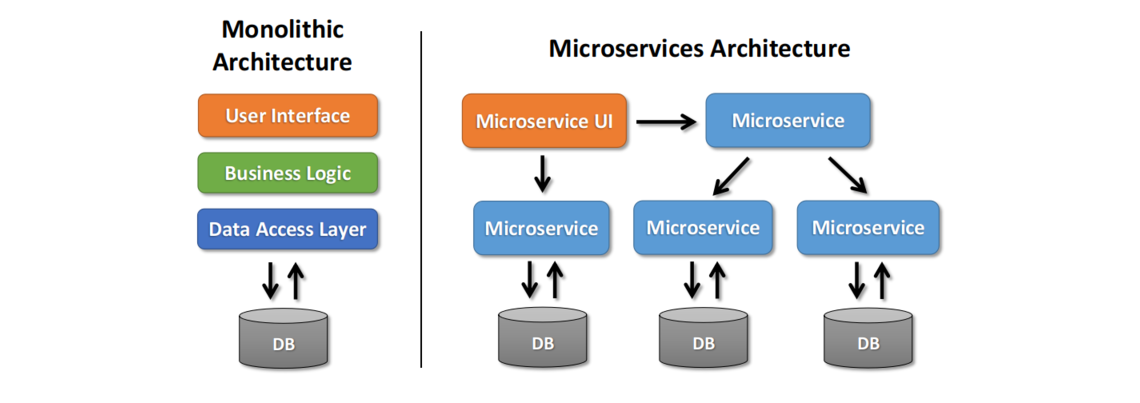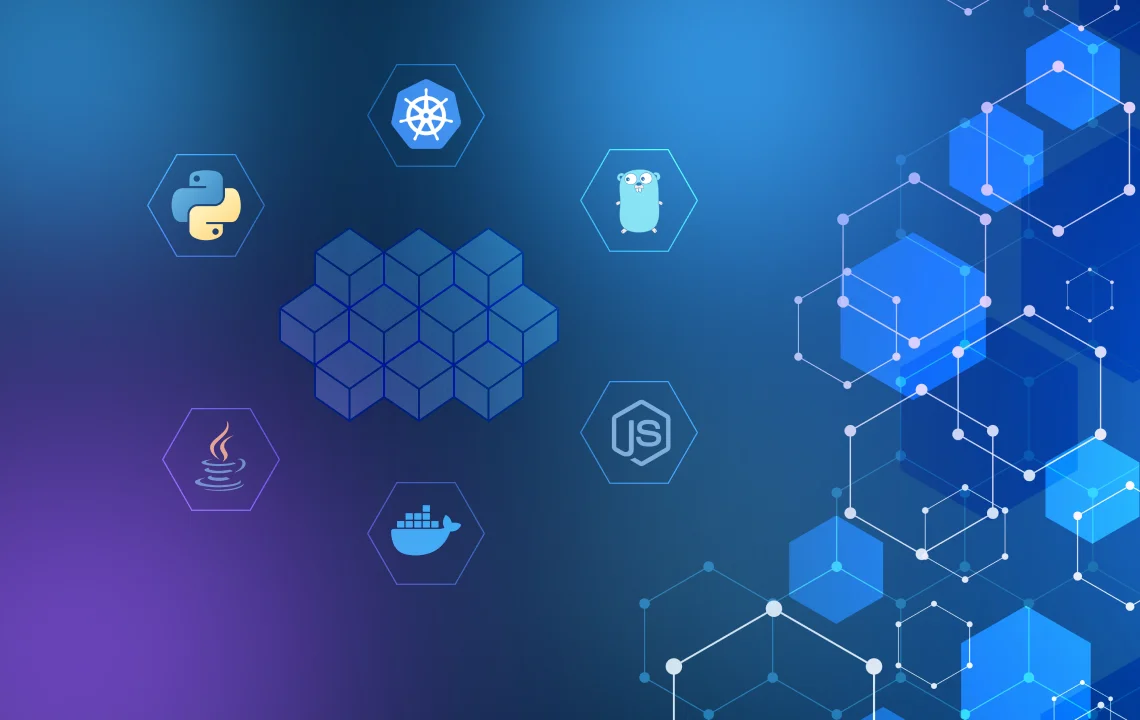Top Technologies and Languages to Pick for Building Microservices Architecture
- DevOps
- September 22, 2023
These days, organizations are creating larger and complex apps that can be used for many services. This is why microservices are becoming extremely popular. As per O’Reilly survey, 61% of businesses have already started using microservices for a year or more.
With an increase in the use of microservices, a question that comes to our mind is “Which languages are technologies are used for creating microservices architecture?”.
Well, many tools and technologies are used for building microservices architecture. But before discussing them, let’s just have a little idea of what microservices architecture is!
What Defines Microservices Architecture?
Microservices architecture is a software development approach that is used to decompose an app into smaller services rather than using traditional monolithic architecture for heavy applications. These services are created to serve different business issues.

The main target of microservices is to simplify the deployment process and build cloud-ready, high-end software programs quickly.
By fragmenting a single app into several smaller programs, you make them simpler to change, scale, and deploy. The microservices architecture employs different data storage technologies. It requires some in-build programming languages also.
With the growing popularity of microservices, many new tools and technologies have developed. Let’s take your look at the most effective technologies for developing microservices architecture!
Best Technologies for Microservices Architecture Development
Microservices can be executed using different tools, versions, and frameworks. Let’s learn more about the technologies that facilitate microservices development!
1. Docker and Kubernetes
Docker is a containerization technology that helps develop, test, and run software systems as self-contained packages in a container. And Kubernetes is a system made for automating the manual tasks engaged in deploying and handling containerized applications. It helps with container scheduling, scaling, and so forth.

Using the combination of these technologies will help build a responsive setup for microservices architecture. It seamlessly scale up or down according to your needs.
Benefits of Docker
- Docker helps you deploy your software easily as you just need to deploy Docker images utilizing Dockerfiles.
- It supports many operating systems, several available plugins that improve its features, and integration with demanding tools and services.
- Docker offers facilities for constant distribution and integration suitable for DevOps culture.
- It’s a lightweight technology to create microservices infrastructure.
- Docker Compose helps coordinate many containers to create the whole system of microservices with containers.
2. REST
REST (Representational State Transfer) is a tool that helps microservices to communicate with other microservices.
This architectural design pattern enables microservices to communicate through HTTP directly. It deals with responses and requests in standard formats, such as JSON, HTML, or XML.
Benefits of REST
- An amazing tool to create a scalable microservice.
- Allows the server and the client to be applied separately without informing the other entity.
- At every side, codes can be changed without impacting one another.
3. Prometheus
Prometheus is an alerting tool & a full-service monitoring system made for multiple complex app topologies containing many nodes. This tool uses key-value labels to execute multidimensional data and provides datastore and scrapes. Prometheus is an easy and rapid tool that filters data depending on their labels.
If you want a grand visualization for statistics and alerts, Prometheus is the right tool. It enables the collection and visualization of data and allows time-based tracking choices to efficiently find anomalous patterns. It’s a great monitoring tool that offers a simplified dashboard interface and different essential graphing instruments.
Benefits of Prometheus
- Supports multi-dimensional data collection and querying.
- Provides an extensible data model that enables to add of arbitrary key-values dimensions to a time services.
- Simple capacity and design to build minimalist apps.
- Perfect for simple microservices software systems.
- Ideal for cloud-native deployed environments.
4. Redis
Being a versatile technology, Redis provides many features that make it strong enough for several applications. It’s a high-speed, flawless NoSQL database that facilitates elastic data structures and quick responses made to fix complicated coding issues using easy commands. Apart from a core data model, Redis also aids Streams, Hashes, and other types of values.
Redis is a high-performing platform. It can manage millions of operations in no time and read operations in a millisecond. Its distributed caching engine is another perk to consider. It covers data persistence, seamless data sharing between microservices, and secure temporary data storage.
Benefits of Redis
- Gives users access to a scalable datastore that provides many servers, apps, and processes.
- Helps optimize the data layer, everything from syncing across geographies to inter-service communication via data management.
- Helps reduce client workload and accelerate the app’s function as a cache manager.
- Multipurpose usage for different data handlings.
5. Consul
Consul technology helps microservices in communicating with one another. Due to its exclusive features, it stands out from the rest service discovery technologies. Because of the Consul Template and DNS interface, you can use Consul with other technologies also.
Using Consul to set up microservices architecture is helpful for the synchronous system. After all, its infrastructure fulfills all the basic challenges of synchronous microservices.
Benefits of Consul
- One of the best service discovery technologies.
- Helps configure microservices.
- Features an HTTP REST API.
- Performs health checks.
- Completely transparent and you can use it with no code dependency.
6. RabbitMQ
This trustworthy message technology facilitates both pub/sub messaging patterns and message queuing and different consistent protocols. Most developers consider RabbitMQ as a unique message broker. To use SSL, you can configure RabbitMQ, which helps make an additional security layer.
While comparing with other message brokers, RabbitMQ offers a more multifaceted performance. It’s great at clustering and can scale up almost half a million messages in a second.
Benefits of RabbitMQ
- Helps with complicated routing communication on a difficult microservice-based app.
- Useful for long-term jobs if you need to run authentic background tasks.
- Features publisher confirms and persistence to help you establish functionality with reliability.
Best Languages for Microservices Architecture Development
Next, you need to consider the languages that work best for creating the microservices architecture. Here is a list of languages that support microservices architecture building:
1. Python
This high-level programming language actively supports integration with various technologies. Python enables fast and easy prototyping in comparison with other languages and frameworks. This is why it is the best option for developers.

Python is compatible with legacy languages, such as PHP and ASP. Developers use a RESTful API method while executing microservices Python. Some established Python frameworks favorable for web app development include Django, Bottle, Falcon, Flask, CherryPy, and NameKo.
2. Golang
Google introduced Go in 2009. Due to its domain name, this language is well-known as Golang. In terms of microservices architecture, Golang is popular for its API support and concurrency features. Its concurrency feature enhances the productivity of different devices also.

To create extremely complex apps, Golang is one of the best platforms that offer great testing support as well. The main 2 Golang frameworks for building microservices architecture include Go Kit and Go Micro.
3. Node.js
Node.js has become a beneficial platform for start-ups and enterprises that need to build microservices architecture in some past years. Since it is created with the V8 runtime, it’s a rapid platform for IO (Input-Output) – bound tasks. In terms of benefitting high performance, lowered costs, higher productivity, and satisfied developers, enterprises rely on microservices Node.js.

Node.js has developed a lot in the last few years. Developers across the world love Node.js for developing apps based on microservices. It hosted almost thousands of open-source libraries on the npm website as well. Often the module you need can be deployed with just a little more development. Hence, it saves lots of time and money.
4. Java
Java is a stable, easy-to-read, and popular programming language among developers. When it comes to building microservices architecture, the Java programming language is more beneficial. Its easy annotation syntax makes it easier to create microservices architecture. Moreover, Java is a great option as it provides a UI, connectivity to back-end resources, and model components.
Java delivers more value in readability when it comes to working with complex systems. The major Java frameworks that support microservices architecture building are Dropwizard, Spring Boot, Spark, and Eclipse Microsprofile.
5. .NET Core
.NET is a perfect cross-platform for microservices. It allows you to use a reliable and established language supported as well as maintained by Microsoft. Its in-built Docker containers help develop microservices. You can use .NET Docker images available on Docker Hub if you want to create your microservices architecture.
You can easily integrate .NET microservices with apps written in Node.JS, Java, or any other language. This gradually helps migrate to .NET core technology. .NET microservices can also benefit you with cloud services.
Microsoft maintains a stable, secure platform named Azure that is also well-suited to .NET. This provides a hybrid method to help you run some modules in the cloud.
6. C++
C++ is a flexible, effective, rapid, and complex programming language. It plays a pivotal role in appliances, robotics, automotive apps, and database services. C++ microservices library provides a great service registry. It relies on the service layer as cited in the OSGi R4.2 specification. The REST SDK cross-platform library also uses C++ microservices.
Final Words
You are recommended to start building microservices architecture from the beginning. It’s tough to choose the perfect technology and language for your microservices. After all, every technology depends on the tool you will employ for creating various app parts. Moreover, your team’s knowledge also matters.
If you have decided to take a step ahead with microservices, find a reliable partner that can complete your project. Choose an expert and skilled organization to pick the right technology and language for building microservices architecture.
If you’re planning to go with microservices and looking for reliable technology partner, contact us now. Our highly qualified team has expertise in custom software development that aligns with your business requirements.













